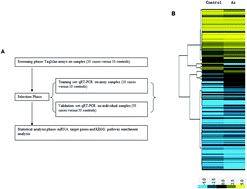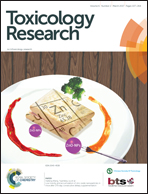Circulating miRNAs and their target genes associated with arsenism caused by coal-burning†
Abstract
Endemic arsenism, caused by burning coal containing high levels of arsenic, is found only in the Guizhou and Shanxi Provinces of China. Dysregulated microRNAs (miRNAs), detected in the blood, are emerging as promising biomarkers. At present, little is known about the change and clinical efficacy of circulating miRNAs in patients with endemic arsenism produced by burning of coal. Here, we determined, by using TaqMan Human miRNA Array Chips, the differential expression of plasma miRNAs between patients with arsenism caused by coal-burning and a control group. Four increased miRNAs (miR-21, miR-145, miR-155, and miR-191) were verified in a larger sample by quantitative real-time PCR. Furthermore, bioinformatics and Kyoto Encyclopedia of Genes and Genomes (KEGG) pathway enrichment analyses were used to associate changes in plasma levels of the miRNAs with their functions and their effects on various pathways. The results of chip array assays show that the levels of miR-21, miR-141, miR-148a, miR-145, miR-155, miR-191, miR-218, and miR-491 were most prominently increased and that the levels of miR-200b, miR-200c, miR-26, and miR-34c were decreased. The qRT-PCR results confirm that the circulating levels of miR-21, miR-145, miR-155, and miR-191 are increased in patients with arsenism caused by coal-burning. KEGG analyses show that these miRNAs inhibit the target genes of pathways related to immune inflammation, oxidative stress, and DNA damage repair. Therefore, the four miRNAs may be biomarkers of endemic arsenism caused by coal-burning. Further studies with larger samples should be performed to confirm these findings and to elucidate the underlying mechanisms.



 Please wait while we load your content...
Please wait while we load your content...